
How does a Research Software Engineer (RSE) — often responsible for developing infrastructure to manage and share digital research objects (data, models, code, notebooks, workflows, etc.) — get from “Yes, FAIR sounds great, but how?” to “I better understand what the FAIR principles really mean and how I can put them into practice.”? I hope the diagram below can help.

